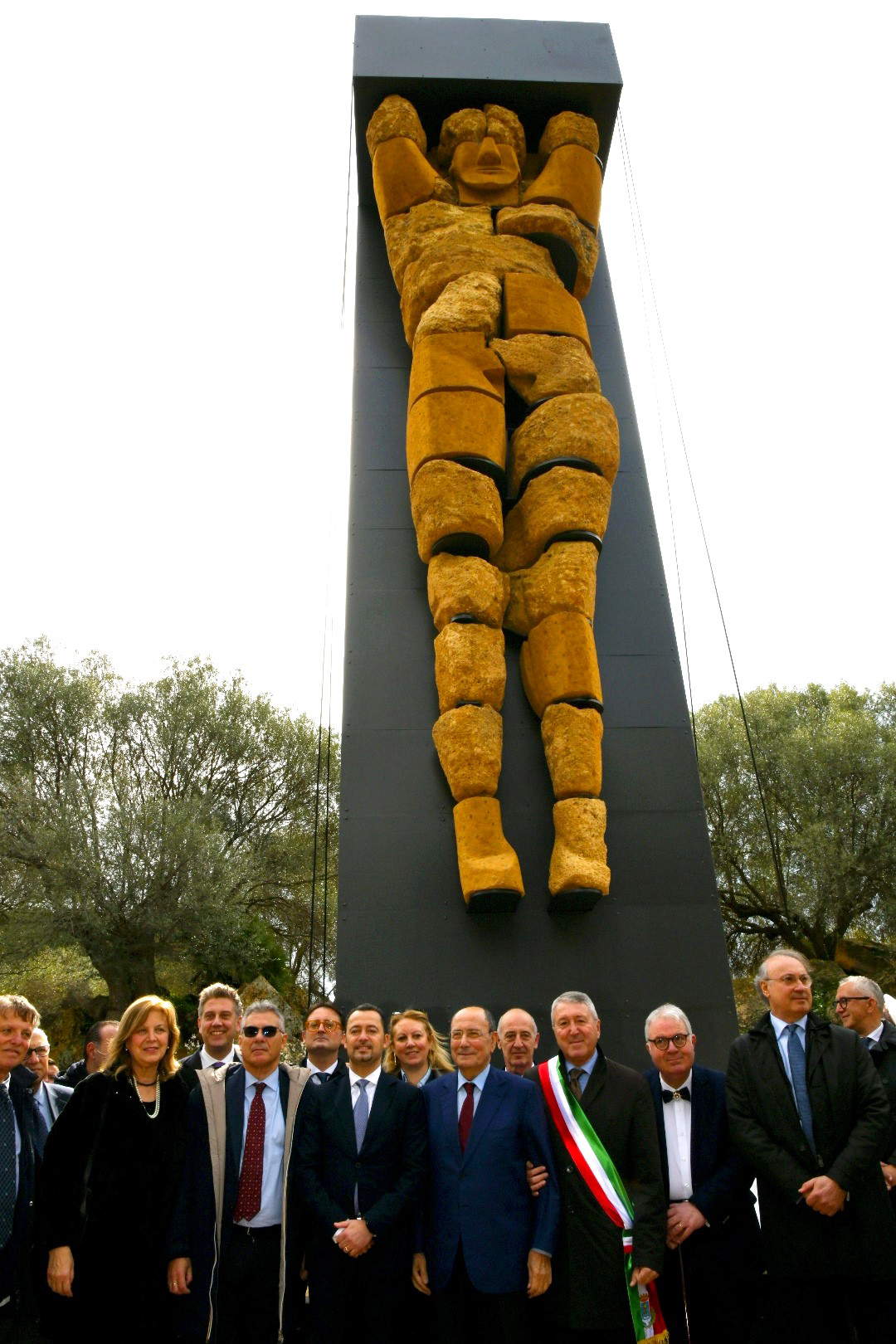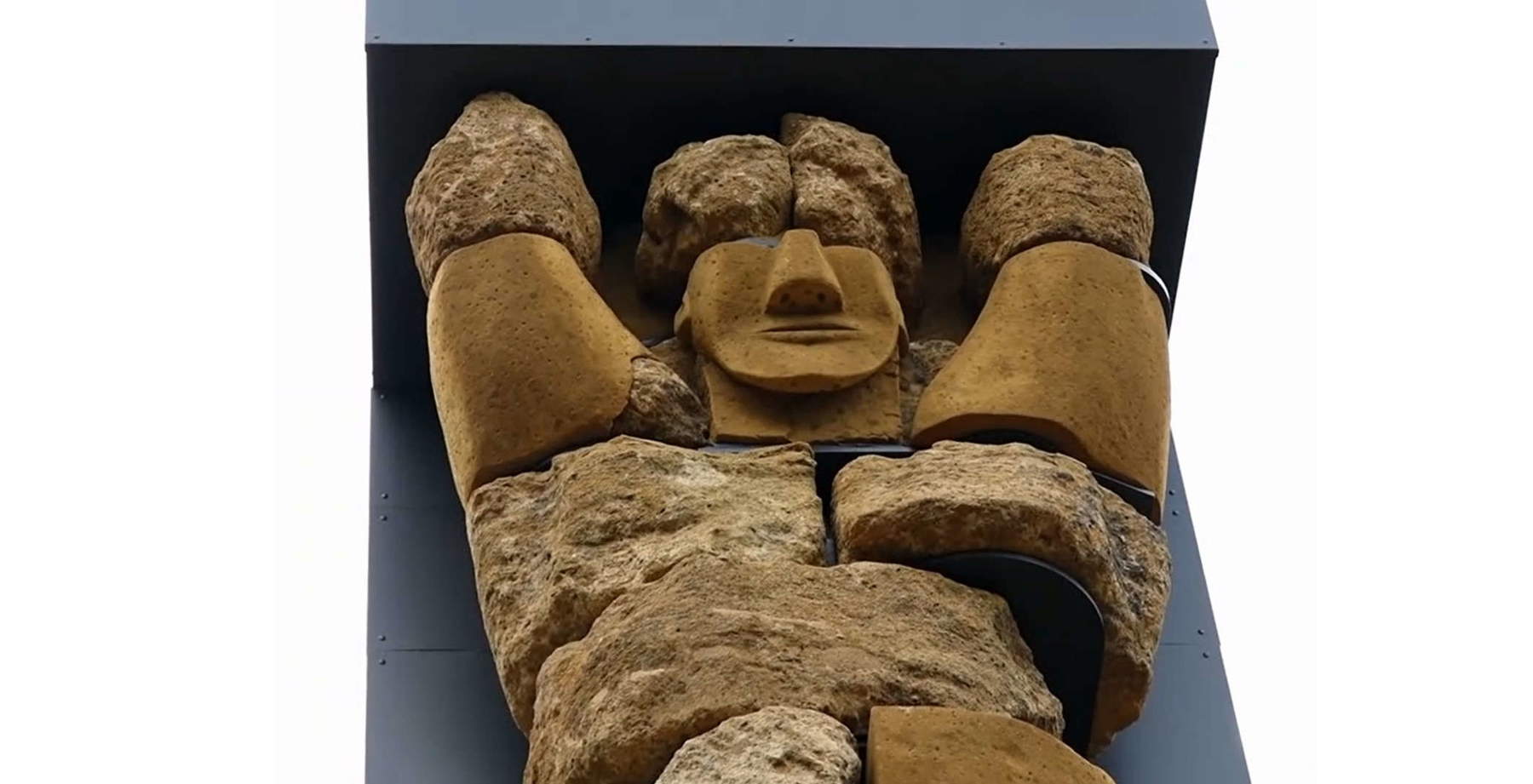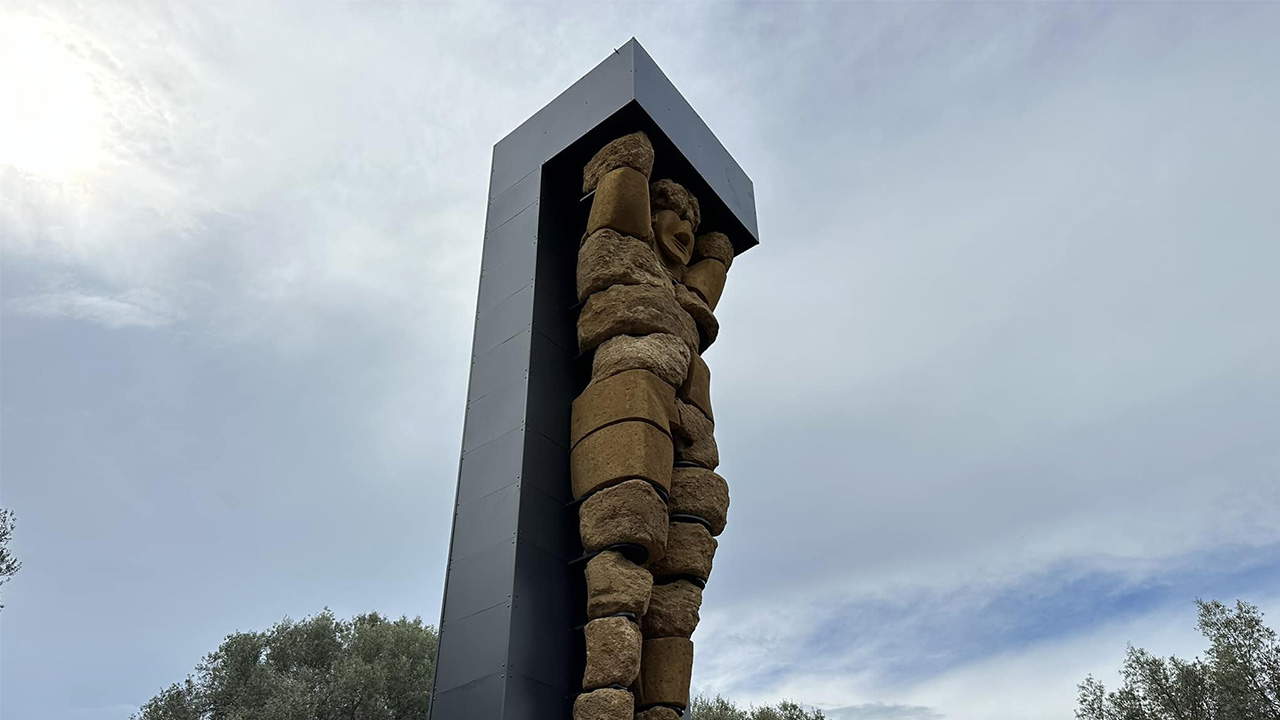Looking and looking again at the telamon of Agrigento, which has created so much stir in the world of archaeologists (much less so in that of architects, and this is no accident), I was reminded of the rhetorical figures of the mundus inversus recounted by the great Tullio De Mauro in the days of my university studies. An upside-down world, also practiced in the graphic arts, in which the roles and functions of living beings and objects are reversed: whereby, for example, it is the man who drags the plow driven by the ox, or the rich man pities a piece of bread at a beggar’s table, etc.
In principle the telamon, as an architectural element, has a static supporting function, and in fact is depicted in the act of supporting with his arms the weight of what is above him, usually the roof of a building. Something very heavy in short. Sometimes he is found with less massive features, sometimes more pronounced, sometimes barely sketched. The ancient world did not need the aesthetic details that seem essential to us to recognize a telamon at first glance and grasp its mythological references.
In Agrigento, in the recomposition of the telamons (the one in the museum, and the one with the new outdoor display), the reversal I mentioned in the opening takes place: the telamon is not solidly planted on the ground to support the weight above its head, but is to some extent “suspended.” It floats, light. I do not know whether to catch a reference to the first of Calvino’s American Lessons; perhaps that would be too much. Certainly the setting betrays the real architectural function of the original (there is an extensive scholarly literature on the subject of the “real architectural function” of the telamons found, to which we refer). And if both telamons in Agrigento are “suspended,” the one in the museum at least is placed below the ceiling of the hall, so the museographic choice adopted allows its function to be more understandable.
The telamon placed outdoors in the archaeological park, on the other hand, eludes functional understanding. It just hangs there. In the support that houses it, one could perhaps catch the citation of the telamon engravings composed during the 19th century. But the quotation still does not hold up to comparison: it is not just an aesthetic judgment, for its being “ugly,” a sentiment widely expressed among the voices that have spoken on the work, remains in the sphere of personal judgment.
If we enter the more specific field of restoration technique, we must do so while remembering that there are different schools of thought in this area. Over time, opposing orientations have prevailed. Cutting the thinking rather crudely, let us say that in restoring the ancient, some advocate the need to harmonize the reconstructed work with respect to its specific context, finding ways to minimize the visual impact of contemporary works necessary for reconstruction. Conversely, others argue that the contemporary should not only not be hidden, but should also be highlighted in a disruptive way.


What is certain is that in this case the choice was not to seek harmony and continuity with the context and landscape of the Valley of the Temples. This dark monolith that stands among the green olive trees, the brownish earth and the off-white of the surrounding artifacts does not silently accompany the work it contains and supports. It overpowers it as much in the wide field (the images from the video footage of the various dedicated television reports are merciless) as in the narrow field (the telamon is suspended, and under its feet there is a wide dark space contrasting with the stone of the giant that certainly does not go unnoticed). Impact in the landscape is not insignificant.
And then there is the question of the pieces that make up the giant: although some have tried to deny the assembly operation from different works, it was Alessandro Carlino himself who clarified that they are “homogeneous stone elements by structure and finding” belonging perhaps to more than one telamon. With some additions that, consistent with the choice not to seek camouflage in the context made for the “container” of the telamon, do not in turn seek camouflage with the other pieces: the material is different and it shows. Questionable (a lot) is the workmanship of the face. All this makes the comparison with “Dr. Frankenstein’s Creature” (a definition that has been very successful on social networks) not offensive, but timely. And if anyone is offended, I lean toward the assumption that they have not read Mary Shelley’s book, but have stopped at the movie quotes. One would almost imagine that the upraised telamon, suffering from the criticism he received, might address his creators like Milton’s Lucifer in Paradise Lost: “Was it I who asked you, O Creators, to endow me with this ungainly face? Was it I who urged you to detach me from the ground to suspend me, heavy and ungainly, in the air?”
The Press Release of the Agrigento telamon, which emphatically announced “the stone giant rises again,” recalled the relevant figures of the enhancement project: Roberto Sciarratta, director of the park, architect; Carmelo Bennardo, curator of the musealization project, architect; and Alessandro Carlino, scientific expert of the project, architect. The organization chart of the Valley of the Temples Park bears the names of: Rosario Maniscalco at “Employee Site Management, Design, Enhancement, Promotion, Maintenance and Restoration,” a law degree and master’s degree in business management; Giuseppe Avenia at the “Pietro Griffo Regional Archaeological Museum of Agrigento,” a business degree. The “Forecast Budget 2023-2025” under the chapter on “Park Personnel,” states verbatim, “The aforementioned staffing, in addition to being significantly insufficient for the performance of all institutional tasks, both administrative and technical, is currently lacking several key professional figures such as the landscape architect, technical and administrative managerial officers, technical instructors, collaborators and operators to be used for the custody of monuments, areas and exhibitions.” Not a word about “archaeologists.” Returning to the telamon project, Alessandro Carlino, an architect, says, “Archaeology needs not criticism, but confrontation, and that is what there has been within the Park, for the last 20 years, in our working group. The standing telamon is not the result of the improvised ingenious stunt of a single scholar, but is developed within a collective investigation sedimented over time.”
Regardless of whether Alessandro Carlino’s “working group” includes at least one archaeologist or not, it is clear that Agrigento lacks archaeologists in the “control room.” But this phrase can also be phrased more broadly: virtually all Sicilian archaeological parks lack archaeologists in functionally decisive roles. And here another reversal occurs, and we understand that Sicily, an autonomous region, likes to do things the other way around. Evidently having archaeologists manage archaeological parks, a phenomenon that is almost generalized on the continent, seemed too much of a given.



By a coincidence of time, the unveiling of the telamon of the Valley of the Temples Archaeological Park overlaps with the (upcoming) release of the Proceedings of the Conference Archaeological Parks. Analysis and Proposals (2022) edited by art historian and journalist Silvia Mazza. On that occasion I presented a paper entitled Archaeological Parks and Archaeologists in Parks. A difficult relationship. There, I pointed out the pointed transgression of national regulations regarding the involvement of the specific professionals authorized to work on cultural heritage under Article 9bis of the Cultural Heritage and Landscape Code. And, to the peace of mind of all the “interpreters” of national legislation in the regional sauce, that legislation must be applied without ifs and buts. On Sicilian cultural heritage, archaeologists, art historians, archivists, etc. must intervene, for their part of competence.
And if the legislation is clear, so is the intention of the scientific community, supported by the political community. In 2012 Francesca Ghedini was invited to chair a ministerial commission that produced fundamental “guidelines for the establishment and enhancement of archaeological parks” (later issued by Ministerial Decree of April 18, 2012). One of the passages proposed things that in Sicily they evidently consider too simple, such as the observation that in archaeological parks “the presence of quantitatively and qualitatively adequate personnel appears to be fundamental, in particular with regard to the positions of scientific direction and those of the scientific committee, which must be composed of experts with documented skills and experience in the archaeological discipline consistent with the main theme of the park.”
Let’s broaden the scope. Segesta Archaeological Area: Director and head of “Dependent site management, planning, enhancement, promotion, maintenance and restoration,” Luigi Biondo, architect. Archaeological Park of Lilybaeum-Marsala: Director, Bernardo Agrò, architect. Archaeological Park of Selinunte, Cave di Cusa and Pantelleria: Director and head of “Dependent site management, design, enhancement, promotion, maintenance and restoration,” Felice Crescente, agronomist. Archaeological Park of Morgantina and the Villa Romana del Casale in Piazza Armerina: Director, Liborio Calascibetta, architect; Head of “Dependent sites management, design, enhancement, promotion, maintenance and restoration,” Rosario Vilardo, architect.
I’ll stop here, because to go any further would be pleonastic and demeaning (as I write, moreover, I learn from the press of the instant revocation-after two days-of the appointment of a manager at the Archaeological Park of Syracuse under investigation for illegal detention of archaeological heritage goods). Clearly, the issue is not the individual professionals listed, who will certainly be excellent professionals in their own fields. The issue is the total and persistent resistance of the Sicilian Region to enforcing national legislation on cultural heritage. When it goes well, a justification for this is sought in a supposed regional autonomy in the matter, which is denied even by constitutional bodies. Very often, especially recently, it is not deemed necessary to even try to seek justification, with contemptuous attitudes for which it would be necessary to quote in full the famous Marquis Del Grillo joke.
And I stop here also because precisely to the pitiful state of degradation of the Villa Romana del Casale in Piazza Armerina a few days ago dedicated an investigation by one of the most important historical signatures of Corriere della Sera, Gian Antonio Stella. He has often devoted attention to Italian archaeology, and to the Sicilian Region’s failure to use professionals in their proper role. On July 24, 2013, for example, in an article devoted to the exploitation of the work of archaeologists by Italgas, expanding the field to Sicily he wrote that “For decades Sicilian art treasures have been seen not as a wealth to be protected and an extraordinary tourist opportunity but as a stipendificio where to place as many friends as possible.”
About the Villa del Casale Gian Antonio Stella first, and Andrea Carandini later, have already said almost everything. I quote Stella: “Eighteen million was allocated, a handful of years ago, for the restoration of the majestic fourth-century residence in the heart of Sicily (...). Without a single archaeologist to have a say. What does a regional councillor for Culture like the current one (Francesco Paolo Scarpinato, an Army marshal who graduated from hotel school and is convinced that ’25 percent of the world’s cultural heritage is in Sicily’) make of an archaeologist put in an archaeological site?”
Here, what does the Sicilian Region do with archaeologists? Apparently nothing. Reports abound here at the National Association of Archaeologists of construction sites and for public works that are unsupervised by archaeologists. Archaeological parks are entrusted to the management of any professional figure except archaeologists. A management for which the most important living Italian archaeologist, Andrea Carandini, goes so far as to utter (with reference to Piazza Armerina) definitive words: “May the world forgive us this depressing degradation that embarrasses the republic before the globe.”
As is evident, in Sicily the world in which everyone does what he or she has been preparing for for years with specific studies seems trivial. And so, in a reversal of concepts, it seems appropriate for the President of the Sicilian Region, Renato Schifani, to say that the raising of the Stone Giant in Agrigento “Certifies the great attention of the regional government to the protection and enhancement of the immense artistic and cultural heritage that our island holds.” Protection and enhancement entrusted, however, to professionals other than those provided for in the Code of Cultural Heritage and Landscape. For the telamon, hyperbole is wasted: “it represents one of the best business cards of Agrigento Capital of Culture,” says Schifani; “a new international ambassador of a unique archaeological site in the world,” says Scarpinato, regional councillor for Cultural Heritage.
I believe that the best calling card for the Capital of Culture would be a double enhancement: enhancing the specialized skills to enhance the cultural heritage. Which is what, in the last ten to fifteen years, is finally being done all over the country. The Sicilian Region should proceed as soon as possible to hold a competition to replenish the regional leadership with real archaeologists and cultural professionals, each in their own area of expertise. The European Conventions of Valletta and Faro have charted a clear path that evidently in Sicily politics struggles to transpose.
We need to get out of the fanciful mundus inversus in which the management of cultural heritage in Sicily finds itself and bring archaeology back to the center of the cultural project: archaeology is a strategic asset of the country. Not oil to be exploited, perhaps polluting. Not treasure to be mined, perhaps thinking about how to monetize. But a resource to be managed and returned to the community and territories as clean energy: from culture new culture is generated, in an essentially infinite process. Cultural heritage must do just that, inspire new culture. And to do this, competent and attentive professionalism is needed.
The suspended telamon in Agrigento and the Villa Romana del Casale in Piazza Armerina are here to remind us, in a different way, that for Sicilian cultural heritage to continue on the current path carries real risks. The reversal of roles and functions is at the heart of the very Italian culture of carnival: which, however, lasts only a week. Then comes Lent, and penance is done. And perhaps it is time for someone in Sicily to start thinking about some restorative foils. Poenitentiam agite.
Warning: the translation into English of the original Italian article was created using automatic tools. We undertake to review all articles, but we do not guarantee the total absence of inaccuracies in the translation due to the program. You can find the original by clicking on the ITA button. If you find any mistake,please contact us.